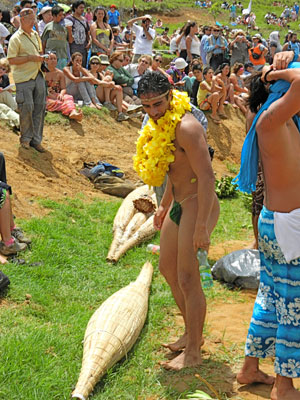Annual Themed Festival: Tapati Festival, Rapa Nui
This item appears on page 32 of the June 2016 issue.
Soon after my husband, John, and I arrived on Rapa Nui, or Easter Island, our hotel hostess, Sophie, asked if we’d like to go see the races. Of course, we said ‘Yes,’ then we piled into her pickup.
When we parked and walked over a small rise, we saw a lovely, blue lake nestled inside a verdant volcano with several hundred folks picnicking on our side of the lake. A race was just starting.
On the opposite side of the caldera, young men in native dress (or undress, each having just a codpiece) ran from the top down to the shore, jumped into narrow reed boats and rowed across the lake. Each then shouldered 15 kilograms of bananas, ran back to the other side of the lake and lay down on another reed boat to arm-paddle across to our side of the lake and the finish line.
While we watched, we each had a traditional tropical drink of sweet peach with a dried peach and several inches of wheat at the bottom.
The race occurs near the beginning of the Tapati Festival, which is held annually in the first two weeks of February. It is organized by locals to strengthen traditional crafts and the unique local culture. The friendly competition is set in motion as Rapa Nui islanders organize behind either of two young women who are each hoping to be queen for the coming year.
The winners of each competition receive points that go to one of the young women. The year we visited, 2012, the rivals were Celine and Lilly.
From the edge of the town, Hanga Roa, a lavishly decorated stage was a comfortable walk away along the coast. We had a chicken-and-rice dinner as we waited for a show to begin at about 9:45 p.m., when it got dark.
Since we were at the first evening show, we listened to introductions of judges and officials. The candidates for queen competed in evening gowns. Two choruses sang original songs, and three individuals performed on guitars and accordions.
The best were the dancing groups of about 300 men, women and children who, wearing handmade costumes of chicken feathers and beaten plant material, came on for each candidate. The performances were outstanding and lasted until nearly 2 a.m.
On subsequent days we watched carvers of both wood and stone. Some were carving statues and others, paddles. Women and men also made woven mats and hats. Some were in traditional dress and others wore T-shirts proclaiming their allegiance to their candidate for queen. These activities took place during the day in a tented area next to the stage.
We stayed at the Kaimana Inn Hotel & Restaurant (Atamu Tekena S/N, Hanga Roa, Easter Island, Chile; phone +56 32 255 1740, www.kaimanainn.com/en_home.php). We paid $360 for our 3-night stay and early check-in.
The inn was very pleasant, with rooms down both sides of a large, common seating and dining area. There was no air-conditioning, but a large, quiet fan was adequate. The breakfast, included in the price, was quite large.
We attended two of the Tapati Festival’s evening performances, and during the day we visited the usual sights: the moai (the island’s famous statues), volcanoes, etc. I was delighted that we just happened to be on Easter Island during the festival. We had four very full days.
LINDA HUETINCK
Alhambra, CA

